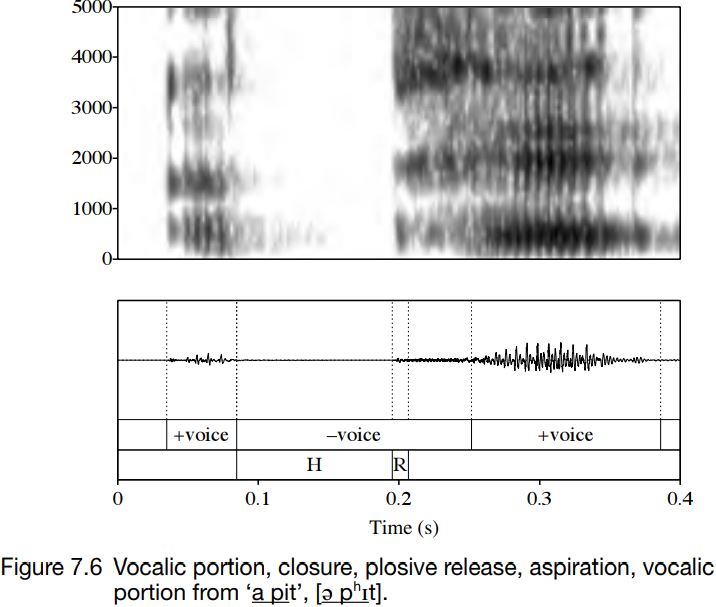


 Grammar
Grammar
 Tenses
Tenses
 Present
Present
 Past
Past
 Future
Future
 Parts Of Speech
Parts Of Speech
 Nouns
Nouns
 Verbs
Verbs
 Adverbs
Adverbs
 Adjectives
Adjectives
 Pronouns
Pronouns
 Pre Position
Pre Position
 Preposition by function
Preposition by function 
 Preposition by construction
Preposition by construction
 Conjunctions
Conjunctions
 Interjections
Interjections
 Grammar Rules
Grammar Rules
 Linguistics
Linguistics
 Semantics
Semantics
 Pragmatics
Pragmatics
 Reading Comprehension
Reading Comprehension|
Read More
Date: 2023-05-11
Date: 2023-08-16
Date: 2023-12-04
|
Voiceless aspirated plosives are the commonest productions of the sounds [p t k] in English. In this arrangement, voicing stops at about the same time as the closure is made. Throughout the closure, the vocal folds are held open, so that the hold phase is voiceless. Vocal fold vibration starts after a delay of approximately 20–50 ms after the release of the closure. For voiceless aspirated plosives, VOT is typically 20–50 ms.

Figure 7.6 shows the lag between release and onset of voicing. After the release, there is a period of noise before voicing begins. This is called aspiration and it is generated by air passing through the glottis and then the vocal tract. Aspiration is a product of turbulent airflow, and sometimes it persists even after the voicing has started.
If you say the phrases ‘a pick, a tick, a kick’ with the back of the hand just in front of the mouth, you will probably feel aspiration as a puff of air. Aspiration is transcribed with a superscript [h]:  . The quality of this aspiration depends on the accompanying vocalic articulation: with front, close vowels (in words like ‘peat’, ‘tick’, ‘king’, ‘cute’ in most varieties), the aspiration has qualities of palatalization; with back, close vowels, the aspiration has qualities of labiovelarisation (in words like ‘port’, ‘took’, ‘queen’ in most varieties); with [r]-sounds, there is accompanying retroflexion, and possibly also labiovelarisation, as in ‘prey’, ‘treat’, ‘creep’.
. The quality of this aspiration depends on the accompanying vocalic articulation: with front, close vowels (in words like ‘peat’, ‘tick’, ‘king’, ‘cute’ in most varieties), the aspiration has qualities of palatalization; with back, close vowels, the aspiration has qualities of labiovelarisation (in words like ‘port’, ‘took’, ‘queen’ in most varieties); with [r]-sounds, there is accompanying retroflexion, and possibly also labiovelarisation, as in ‘prey’, ‘treat’, ‘creep’.
The degree and duration of aspiration depend on word and sentence stress. The more prominent a word is, the more aspiration with any voiceless plosive in it, it is likely to have.
|
|
|
|
لصحة القلب والأمعاء.. 8 أطعمة لا غنى عنها
|
|
|
|
|
|
|
حل سحري لخلايا البيروفسكايت الشمسية.. يرفع كفاءتها إلى 26%
|
|
|
|
|
|
|
قسم الشؤون الفكرية يقيم الحفل الختامي لمسابقة حفظ قصار السور للناشئة في أفريقيا
|
|
|